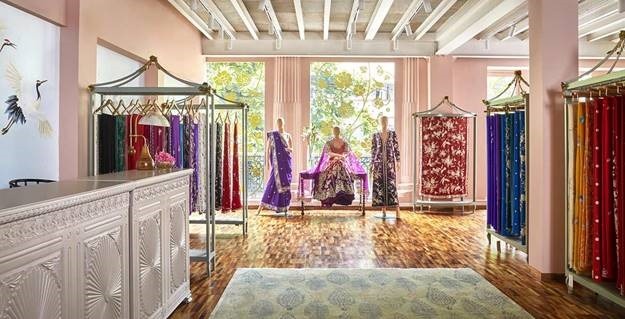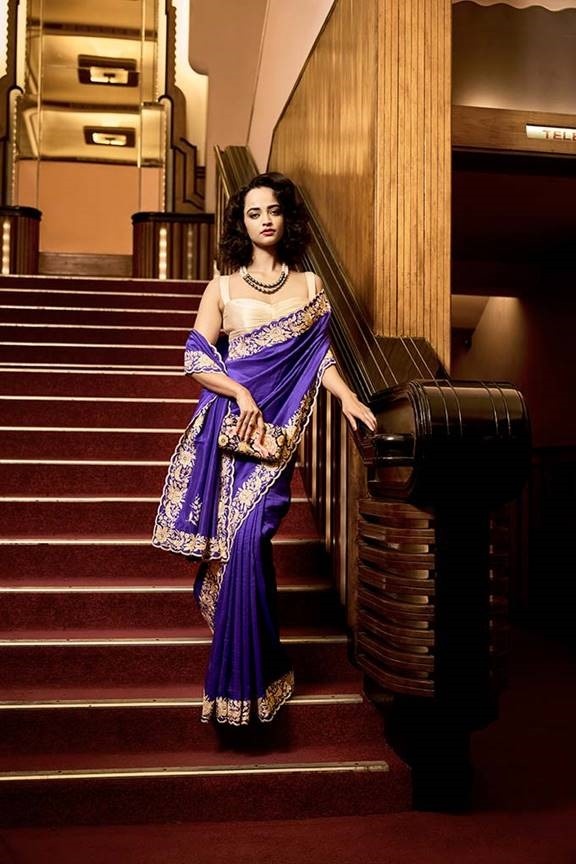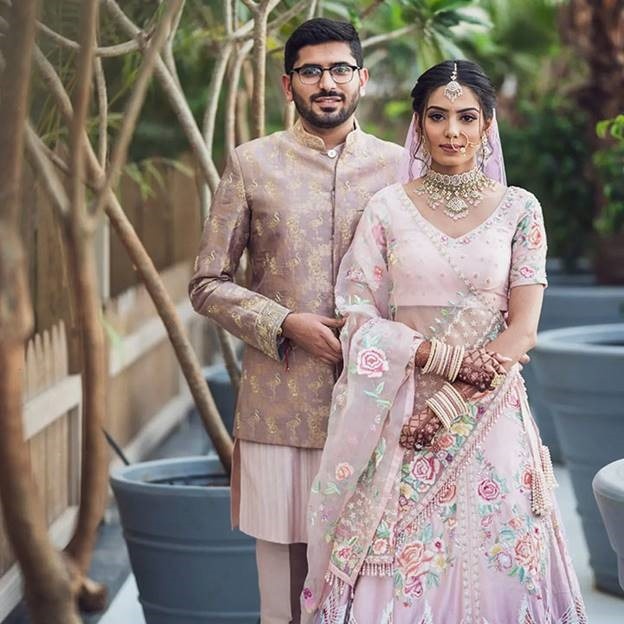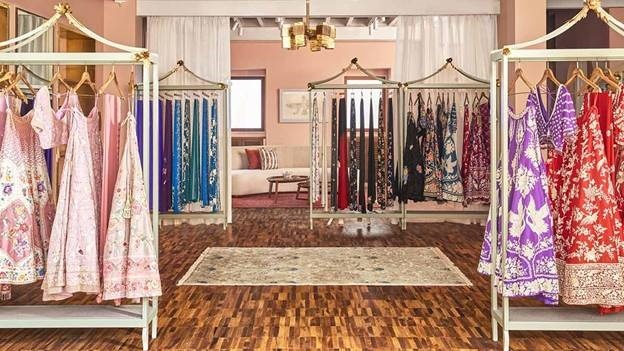At his Mumbai store launch, designer Ashdeen Lilaowala talks of the Parsi gara’s evolving fanbase
This year, Ashdeen Z. Lilaowala, founder of label ASHDEEN, marks a decade of working with the traditional Parsi gara. The designer’s brand new store in Mumbai’s Colaba neighbourhood marks this event and reboots the city’s historical relationship with its vibrant Parsi community and its exquisite gara embroidery. For Lilaowala, who grew up in the city, setting up shop here feels like a homecoming rather than a business expansion. “For me, the city is still Bombay”, he says, “I look at it as I did when I was a 16-year-old. It holds a lot of nostalgia and romance for me.”
Article By Shubham Ladha | Voice Of Fashion
ASHDEEN’s new store in Colaba, Mumbai.
The Mumbai store opens with a new collection. ‘Liz in Bombay’, is steeped in nostalgia yet modern. The retail space has been conceptualised by interior designer Ali Baldiwala keeping Lilaowala’s Art Deco fascination in mind. Hand-carved furniture, pale pink walls with artist Kanak Nanda’s chinoiserie-inspired murals, brass-stencilled window screens and panels, mint-green racks, are part of the carefully-put-together aesthetics. The ‘Liz in Bombay’ campaign—featuring model and actor Anjali Sivaraman in jewel-toned saris in fabrics such as raw silk, satin and crepe jacquard, with colourful, shimmering embroidery—captures a similar spirit. The collection is inspired by Elizabeth Taylor; Lilaowala imagined what it would be like if the late Hollywood legend came to Mumbai for a film premiere at Liberty Cinema.
A campaign still from ASHDEEN’s new collection ‘Liz in Bombay’, featuring model and actor Anjali Sivaraman in the ‘Ruby’ sari.
In the early 19th century, Parsi traders established a roaring trade with the Chinese and others from Southeast Asia. According to historical records, the Chinese discovered and wore silks which they embroidered with vivid nature-inspired motifs using an intricate satin stitch technique. They introduced them to the Parsi community who began to wear these textiles as saris—a tradition that continues to this day. Lilaowala’ is among the first designers from the community to have centred his work on the gara, with a focus on contemporising the craft and making it covetable to a wider consumer base and as a fashion statement.
Keeping with the Gara
A National Institute of Design (NID), Ahmedabad graduate, Lilaowala worked as a researcher with the Ministry of Textiles, alongside UNESCO’s Parzor Foundation before turning designer. His research on gara embroidery culminated in the book, Threads of Continuity – The Zoroastrian Craft of Kusti Weaving (Parzor, 2013), in which he highlighted the symbolic significance of the craft for Parsis. He says: “There’s never been one definition, guidebook or clear reference point for the craft because it has had Chinese [and East Asian] as well as European and British influences. It can still be influenced further, making it richer and better.” Due to its multi-cultural origins, Lilaowala considers the craft as an ever-evolving process and an aesthetic in itself. “People confuse the craft for being an embroidery technique, but it uses techniques which are used in several other crafts,” he adds.
A campaign still from ASHDEEN’s new collection ‘Liz in Bombay’, featuring model and actor Anjali Sivaraman in the ‘Shelley’ sari.
Since starting his label in 2012, Lilaowala has been clear about having his “own voice” as a designer that adds to the textile traditions of the gara. He plays with the proportion of classic flora and fauna motifs in the embroideries, uses organza and net as base materials or combines fabrics to create new surfaces—interventions untried before. In the ‘Liz in Bombay’ collection, saris feature Persian-inspired open jaal (lattice) work and border with ombré peonies on diaphanous blush pink organza. The ‘Rhapsody’ sari is a standout, brimming with bright embroidered roses, chrysanthemums and birds, against a deep purple. Classic motifs—kanda-papeta (polka dots named after onion and potato), roses and cranes, birds that have become synonymous with the ASHDEEN design DNA—recur across his designs, but offset with unusual colours and scaled to playful proportions. Chinese inspirations are explored in saris, where landscapes are embroidered across the length akin of tapestries. The use of colours such as sand grey and pastels, metallic embroidery or sequins and beadwork as accents add more novel elements to the ensembles.
Due to its multi-cultural origins, Lilaowala considers the craft as an ever-evolving process and an aesthetic in itself. “People confuse the craft for being an embroidery technique, but it uses techniques which are used in several other crafts,” he adds.
In addition to saris, Lilaowala introduced gara embroideries in Westernwear staples and separates. While Parsi brides always wear gara saris on their wedding days, Lilaowala also offers a line of gara lehengas which find many takers among non-Parsi brides, as well as coordinated accessories such as bags and potlis. At the launch soirée at his store, attendees—family, friends and industry insiders—wore the gara on boxy blouses and calf-length overcoats.
While Parsi brides always wear gara saris on their wedding days, Lilaowala also offers a line of gara lehengas which find many takers among non-Parsi brides.
Bride Natasha Majithia in ASHDEEN’s ombré ‘Isfahan lehenga’ and groom Vishan in a customised brocade ASHDEEN ‘bundi’ that complements the bride’s ensemble.
Lilaowala’s efforts to contemporise the textile has led him towards collaborations. In 2016, he wove traditional gara motifs such as birds and flowers onto Banarasi brocade silks, for Ekaya. Earlier this year, he collaborated with Kanjeevaram-focused sari label Kanakavalli to create Kanjeevaram saris woven with gara motifs. Lilaowala recalls being warned that he would “kill gara” by combining it with other crafts, and nobody would buy it. “I feel we don’t have to be so purist and stuck up about it. Sure, some things will work and some things won’t, but [let’s] keep giving the market something new,” he says. Lilaowala has even translated gara motifs into prints for chiffon and crepe saris.
The Eyes and Hands of the Craft
For his craft-intensive collections, Lilaowala works with both Parsi and non-Parsi craftspeople—the latter often from West Bengal and Uttar Pradesh. Lilaowala and his core artisanal team trains the karigars who aren’t familiar with the craft or its nuances. “There is a certain eye you have to have about how gara motifs and their colours move,” says the designer. He ensures that his relationship with the artisans is a partnership so that their talent is respected and not overshadowed. He pushes them to find references online and suggest their own ideas. “It’s the artisans’ hands that embroider,” he points out.
A post shared by ASHDEEN (@ashdeenl)
With a flagship store in Delhi (where he now lives) since 2018 and now in Mumbai, Lilaowala caters to a clientele that transcends the community. “While each craft holds its own ground, for this new clientele, the clothes can be played with and made the clients’ own while having fun with their style,” he says.
ASHDEEN’s new store in Colaba, Mumbai.
The retail space has been conceptualised keeping Lilaowala’s Art Deco fascination in mind.
Following two years of the pandemic, Lilaowala hopes his designs—abounding in dopamine colours and vintage-inspired patterns—will offer a sense of drama and escapism to his wearers. As he says, “These aren’t clothes you wear every day, but you wear them to celebrate special milestones—that’s where the joy is.”
Banner: Ashdeen Z. Lilaowala and campaign still from ASHDEEN’s new collection ‘Liz in Bombay’, featuring model and actor Anjali Sivaraman.





